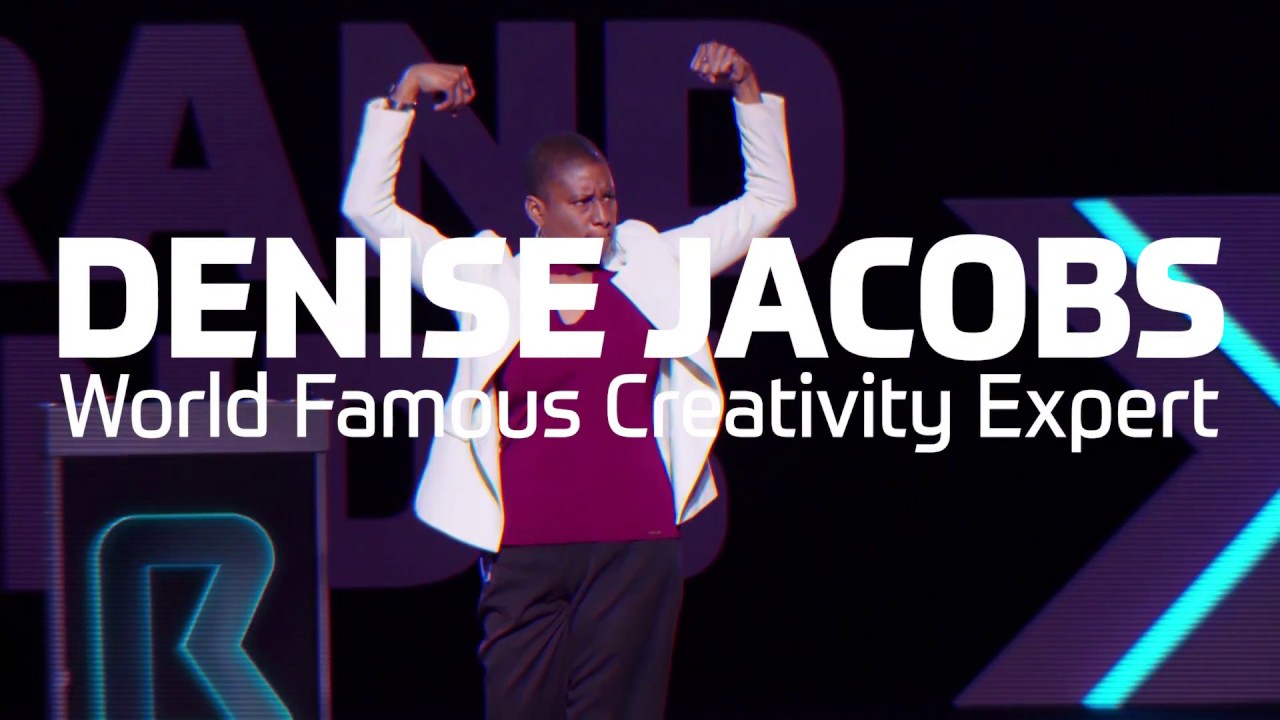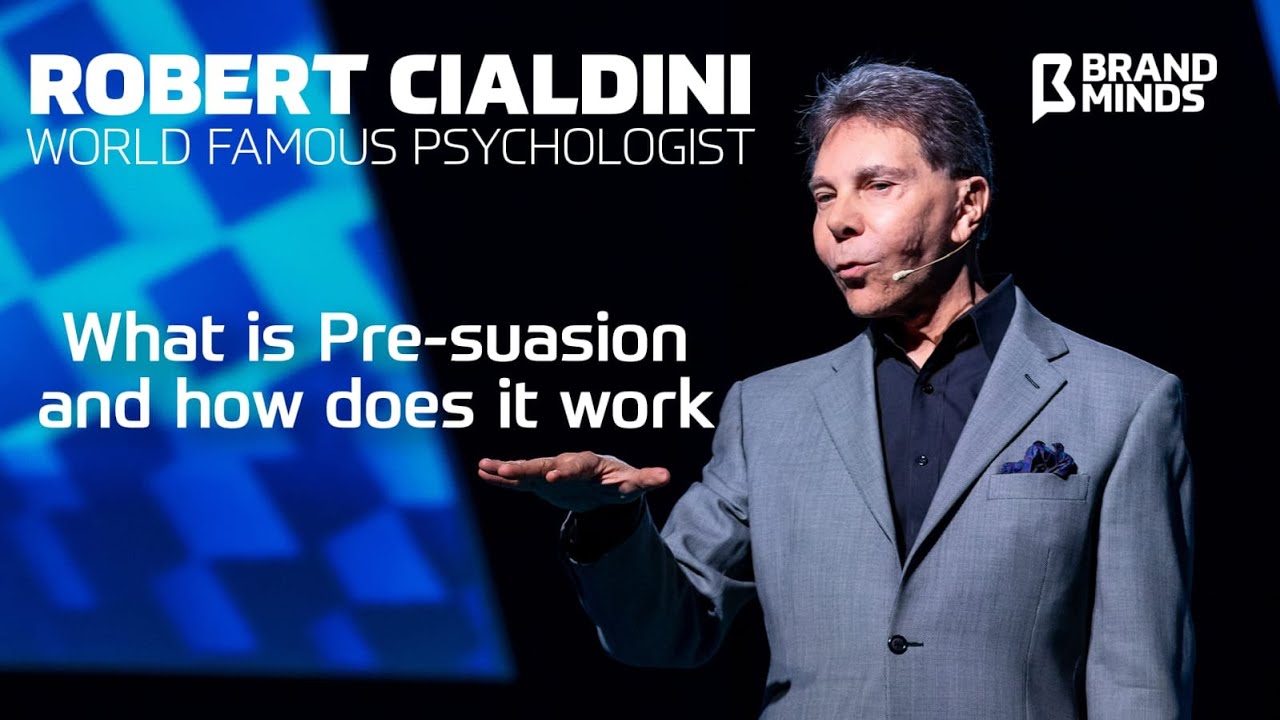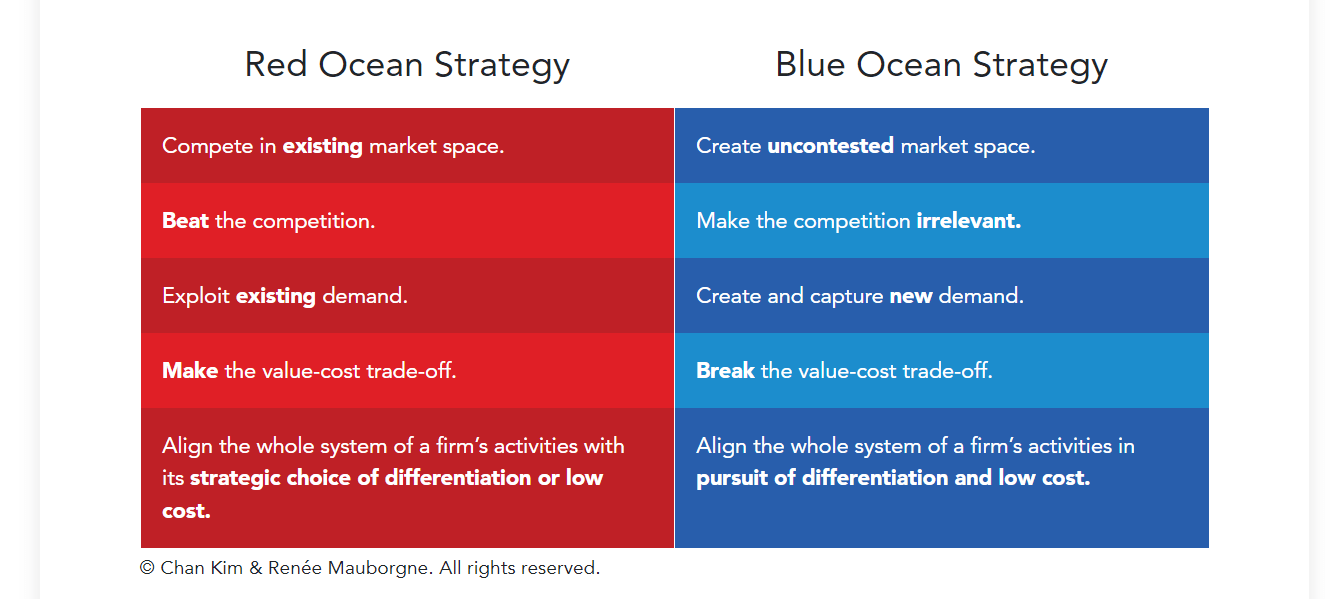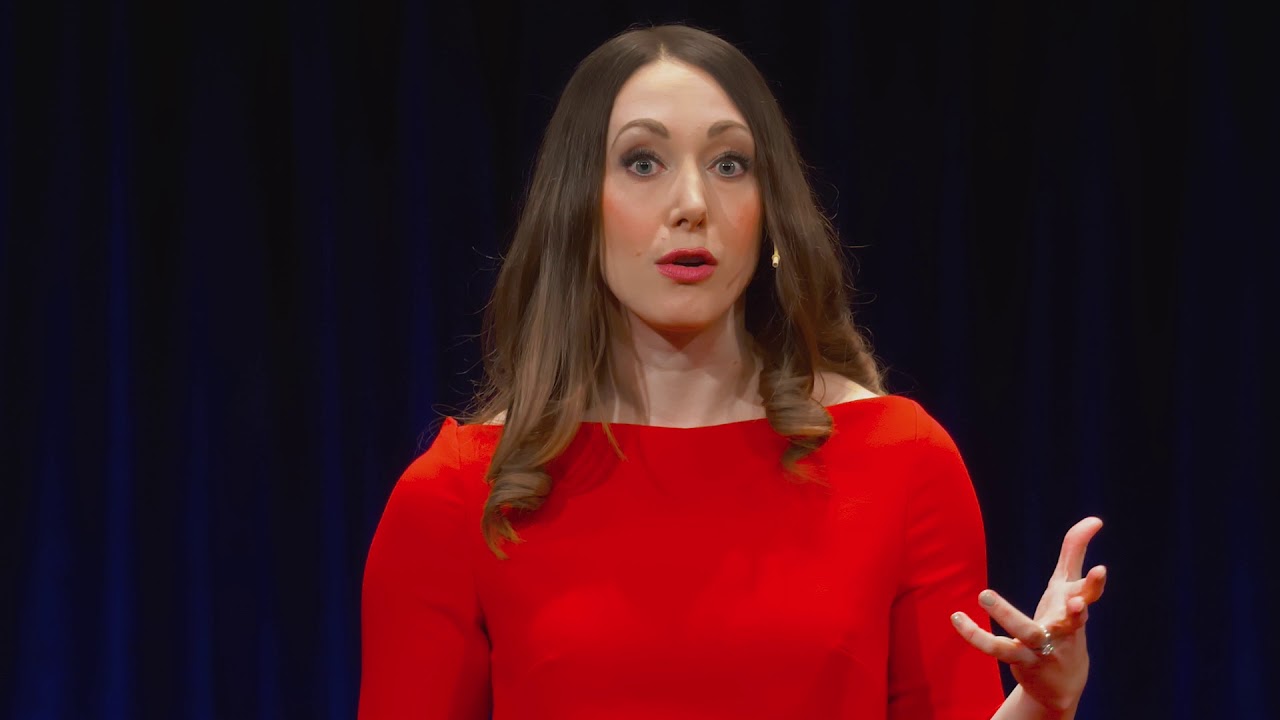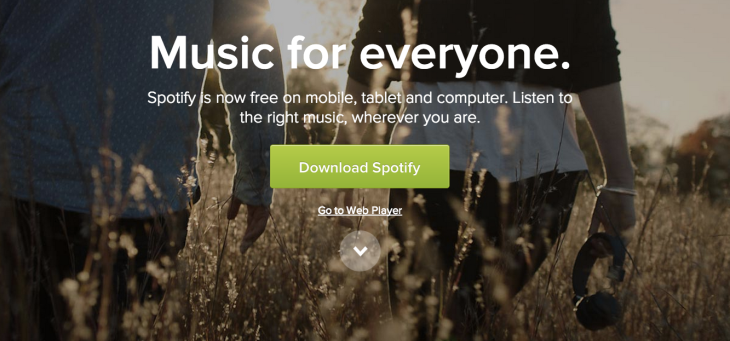Video streaming industry expected to grow to $150 billion by 2026
According to the latest research, the video streaming industry is expected to grow to $150 billion by 2026 at CAGR of 18%.
In this article:
- Video streaming industry stats and facts
- Key factors driving the video streaming industry growth
- Key restraining factors for the growth of video streaming industry
- Opportunities
Video streaming industry stats and facts
![]() Due to lockdown, Internet users are spending 32% of their time on streaming devices and platforms (Market);
Due to lockdown, Internet users are spending 32% of their time on streaming devices and platforms (Market);
 54% of Internet users are watching more shows and films on streaming services due to Covid-19 (Market);
54% of Internet users are watching more shows and films on streaming services due to Covid-19 (Market);
 Key players in the video streaming software market: IBM, Vimeo, Brightcove, Qumu, Kaltura, Wowza etc;
Key players in the video streaming software market: IBM, Vimeo, Brightcove, Qumu, Kaltura, Wowza etc;
 Key players in the VoD market: Netflix, Hulu, Disney, HBO, Apple, Google, AT&T, Amazon, YouTube;
Key players in the VoD market: Netflix, Hulu, Disney, HBO, Apple, Google, AT&T, Amazon, YouTube;
 Media and Entertainment, BFSI, Healthcare, and Academia and Education, eCommerce contribute to ~60-70% of the market;
Media and Entertainment, BFSI, Healthcare, and Academia and Education, eCommerce contribute to ~60-70% of the market;
 The fastest-growing video streaming market is China. China’s live-streaming industry has more than doubled in size compared with the previous year, reaching now $5 billion (Researchgate);
The fastest-growing video streaming market is China. China’s live-streaming industry has more than doubled in size compared with the previous year, reaching now $5 billion (Researchgate);
 In India, the video streaming industry is projected to reach $465 million by the end of 2020 (Statista)
In India, the video streaming industry is projected to reach $465 million by the end of 2020 (Statista)
 The largest video streaming market is the US. Here the video streaming industry is projected to reach $24 billion in 2020 (Statista)
The largest video streaming market is the US. Here the video streaming industry is projected to reach $24 billion in 2020 (Statista)
 The fastest-growing segments in the video streaming industry are:
The fastest-growing segments in the video streaming industry are:
- Video Analytics. Video analytics allow service providers to better understand their audiences, serve them better and thus, remain competitive.
- Live streaming. Live streaming helps audiences feel more engaged and more connected with the person in front of the camera.

Key factors driving the video streaming industry growth
 Increasing penetration of mobile devices and internet users
Increasing penetration of mobile devices and internet users
In 2020, the number of global smartphone users is projected to total 3.5 billion, marking a 9.3% increase from 2019. The current global population of 7.7 billion people means the smartphone penetration rate is at 45.4 %. (Oberlo)
Almost 4.66 billion people were active internet users as of October 2020, encompassing 59% of the global population. Mobile has now become the most important channel for internet access worldwide as mobile internet users account for 91% of total internet users. (Statista)
 Growing demand for VoD streaming
Growing demand for VoD streaming
According to Cisco, video will account for 82% of all Internet traffic by 2022.
 Remote work & Lockdown
Remote work & Lockdown
The COVID-19 pandemic has had serious consequences on business too with a large number of employees working remotely.
More than 1/4th of the world’s population went into lockdown. This has resulted in increased demand for online streaming and entertainment services.
Netflix added 26 million new subscribers in the first six months of 2020 which accounts for the company’s biggest growth spurt in history. As of the third quarter of 2020, Netflix had 195.15 million paid subscribers worldwide. (Forbes)
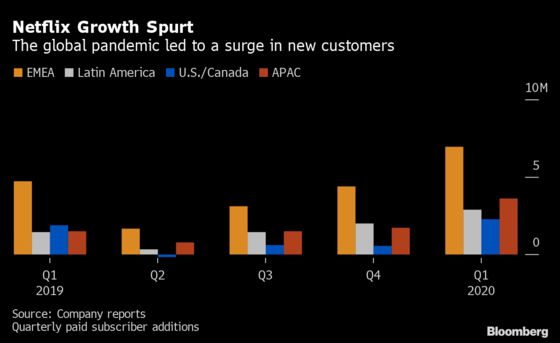
Disney+ launched a year ago with the goal of reaching 60 million to 90 million subscriptions by 2024. The company has recently announced that the platform surpassed 74 million subscribers by the end of 2020, outperforming all expectations. (CNBC)
Apple TV+ also launched a year ago and is included in the company’s One subscription bundle. The company hasn’t released any info regarding the number of its paying subscribers but estimations range from 10 million to 40 million subscribers. (TheVerge)
As of January 2020, there are over 150 million Amazon Prime Video users. (Market)
 Growing adoption of cloud-based solutions
Growing adoption of cloud-based solutions
The global public cloud service market is projected to reach $266 billion in 2020. This spells out a projected growth of 17.3% since 2018. According to Gartner’s forecast, infrastructure-as-a-service (IaaS) solutions, like cloud storage, will be the fastest-growing segment of the market with 24% predicted growth. (Hosting Tribunal)
 Growing demands of Live Video streaming solution
Growing demands of Live Video streaming solution
Over the past few years, going live on Facebook has become a popular feature among its users. Today live video is on almost every social platform: Instagram, Twitter, LinkedIn, Snapchat, YouTube etc.
 Technology innovations like blockchain and AI
Technology innovations like blockchain and AI
Video streaming as a service relies entirely on technology. Video streaming is not possible without video storage, encoding, networking and streaming. Blockchain technology expands storage options by spreading data across the blockchain computer network. Streaming video will be able to tap into underutilized computers through the Blockchain, which will dramatically reduce streaming’s cost (learn more).
From face recognition to chatbots and disease mapping, AI has a wide range of applications across many verticals. In video streaming, AI helps with workflow optimization, content-aware encoding and bandwidth use optimization while maintaining an appropriate level of quality. The main benefit of using AI in video streaming is cost saving.
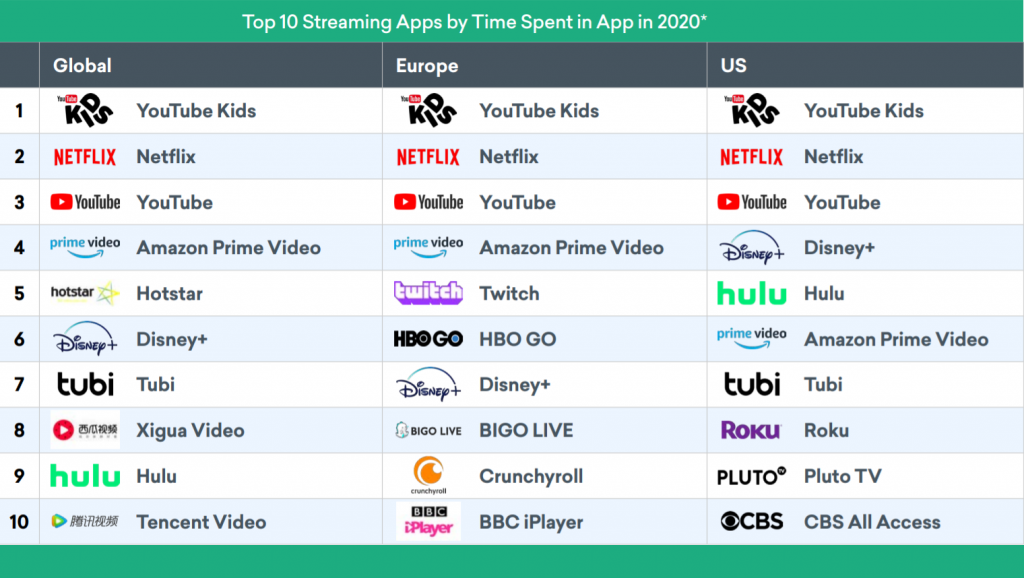
Key restraining factors for the growth of video streaming industry
- connectivity issues;
- latency and bandwidth issues which may result in poor quality video;
- a surge in internet traffic;
- data loss due to buffering;
- the disparity among software systems;
- high content cost;
- easy availability of pirated data;
- loss of personal and financial details.

Opportunities
Over the past few years, digital transformation has been in the top three goals for businesses everywhere.
The pandemic-induced lockdown forced businesses that had already started down this path to speed up and businesses that had a traditional high-street or in-person revenue generation model to pivot toward online and digital.
As a result, this year has seen teachers teach classes online to students ranging from first-graders to executive MBA participants.
Doctors see their patients through their PC’s camera first and popular talk show hosts broadcast from their homes.
Live music and business events have gone online, each of them looking to provide attendees with the best experience possible.
International banks with thousands of branches worldwide are making the most of the digital environment allowing their clients to keep safe.

Conclusion
Video streaming industry is projected to grow to $150 billion by 2026.
The industry has been growing steadily in recent years but the pandemic has accelerated its growth.
Remains to be seen if the industry will maintain its growth rate after the pandemic is over.
Join the Conversation
We’d love to hear what you have to say.
Get in touch with us on our LinkedIn Page, Facebook Page, Twitter or TikTok.
Top 5 most in-demand soft skills you need to grow in 2021
Looking to develop your soft skills? Read on to discover the Top 5 most in-demand soft skills you need to grow in 2021.
Professional growth and career advancement hinge on the employee’s desire and ability to learn new things.
Whether you are looking to specialize in your field which means you’d want to go deep, or you are looking to diversify which implies going left and right (learn more about the T-shaped marketer), learning never stops. And it shouldn’t, rightfully so.
Over the past few years, LinkedIn, the 722-million member professional social platform, has been curating a list of the most in-demand soft and hard skills employers are looking for.
Here is LinkedIn’s list for the most in-demand soft and hard skills 2020.
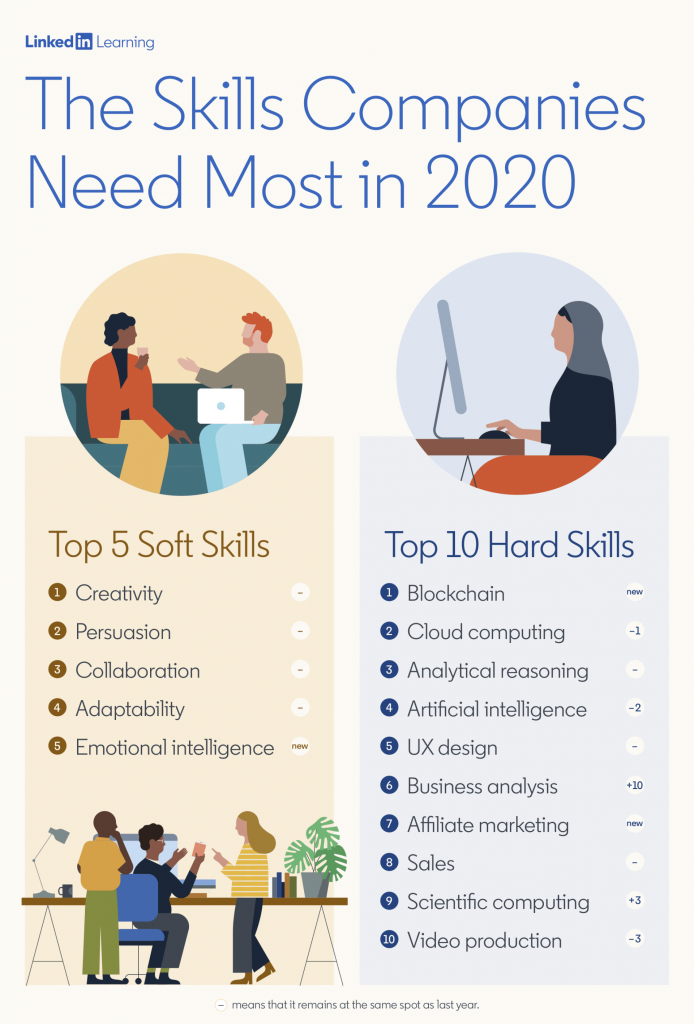
What are the Top 5 soft skills companies look for in their employees and new hires in 2020?
- Creativity
- Persuasion
- Collaboration
- Adaptability
- Emotional intelligence
Let’s talk about each of them.
1. CREATIVITY
Creativity is now the #1 soft skill companies are looking for three years in a row.
Why is creativity in such high-demand?
Listen to creativity expert and BRAND MINDS speaker Denise Jacobs:
Can creativity be taught or is it an inherent trait?
I believe one of the most creative organizations in the world today is NASA. Going into space requires finding solutions to unique problems and even unknown situations. That certainly pushes the brightest minds at NASA to come up with creative and out-of-the-box solutions.
In the 1960s, NASA reached out to Dr George Land, a creative performance researcher and enrolled his expertise in devising a creativity test to help with the selection for innovative engineers and scientists. Dr Land accepted the challenge and devised a creativity assessment that worked very well.
Inspired by the results and curious to know more about where creativity comes from, Dr Land conducted a research study to test the creativity of 1,600 children ranging in ages from 3 to 5 years old. He re-tested the same children at 10 years of age, and again at 15 years of age. And then he extended the testing pool to include 1 million adults.
What exactly did Dr Land test for?
He tested for the ability to look at a problem and come up with new, different and innovative ideas.
Here are the results:
5-year-olds: 98% imaginative
10-year-olds: 30% imaginative
15-year-olds: 12% imaginative
31-year-olds: 2% imaginative
That’s quite a shock, isn’t it?
We are the most creative in our childhood and we lose our creativity growing up.
What is the reason?
Dr Land gave the following explanation in his book, Breaking point and beyond:
What we have concluded is that non-creative behaviour is learned.
Is there something we can do about it?
In his 2016 Tedx Talk, Dr Land says there is a way to undo this process.
Let’s hear from Dr Land (08:37):
First of all, we need to think about creativity beyond artistic abilities.
Artists are not the only creative people.
Professionals in every industry have the ability to be creative. Because in the workplace, being creative means looking at a problem from a different viewpoint and coming up with a fresh solution, as Dr Land explained a few years ago.
It’s not about waiting to be inspired; it’s about thinking creatively.
According to Martin Lindstrom, brand expert and BRAND MINDS speaker, the first step towards creativity is taking time off from your smartphone, observing the people around you and essentially allowing yourself to be present.
2. PERSUASION
In business communication, persuasion is the process of presenting arguments to move, motivate, or change your audience.
Persuasion is one of the most important skills that a leader needs. He has the vision and he sets the goal; he needs to move and motivate his employees to fulfil the vision and meet the goal.
It’s the leader who tells his colleagues Come with me and let’s accomplish the mission together. This is the authoritative leader who provides employees with inspiration, motivation, empowerment and a sense of accomplishment.
Or the visionary leader whose motto is Embrace my vision. This type of leadership is called visionary leadership. The visionary leader must hone his persuasion skills to inspire and motivate people to pursue a long-term vision. Learn more about leadership styles: 12 Leadership Styles for Successful Leaders (complete list) with Pros & Cons.
Persuasion skills are necessary for sales and marketing as well. With a 30-year career researching the science of influence, Dr Robert Cialdini is the world’s most renowned persuasion expert and a BRAND MINDS speaker.
His Theory of Influence is based on seven key principles:
- Reciprocity,
- Commitment and consistency,
- Social proof,
- Authority,
- Liking,
- Scarcity,
- Unity.
Brands build on them to increase brand awareness and sales. Dr Cialdini’s latest insights on persuasion are in his 2016 book Pre-Suasion: A Revolutionary Way to Influence and Persuade.
3. COLLABORATION
We are living and working in a fast-paced environment.
Startups with a handful of employees that work as one are able to move quickly and more efficiently. Corporations with thousands of employees are slow and bureaucratic.
There are many examples of hundred-year-old brands outcompeted by new entrants on the market.
That’s where agility comes into play as a way of organizational transformation with one goal: adapt.
Want to learn more about agility? Read 22 benefits of the agile organization.
For an organization to become agile, its employees must form small teams. Every team member is expected to collaborate with each other. And that’s more difficult than you might think.
To meet the set goals, team members must learn to listen to each other, be supportive, be generous, learn to communicate clearly and openly, share knowledge and information, refrain from judgement, reject bias, debate and adapt.
The team leader must also be an example of effective communication and collaboration.
4. ADAPTABILITY
At the time of writing, the world has been fighting to end the COVID-19 pandemic for almost a year.
Our private and professional lives have been profoundly affected.
Many businesses are fighting to survive while others have already closed their doors. Adaptability has never been more important.
Why are companies looking for employees with a high ability to adapt?
Because these employees are a great asset to the company.
Highly-adaptable employees are:
- Willing to experiment;
- Undeterred by failure;
- Use the failure as an opportunity to learn;
- Resourceful;
- Keep an open mind;
- Have a growth mindset.
5. EMOTIONAL INTELLIGENCE
Emotional intelligence is a new entry in LinkedIn’s Top 5 most in-demand skills of 2020.
Why are companies looking for emotional intelligent employees?
Let’s first find out what is emotional intelligence.
Emotional intelligence is the ability to perceive, evaluate, and respond to your own emotions and the emotions of others. It’s the skill that facilitates and nurtures the other four.
Daniel Goleman, one of the world’s leading psychologists and BRAND MINDS speaker, introduced the concept of EQ or emotional intelligence in his 1995 bestseller, Emotional Intelligence.
According to Daniel Goleman, there are 5 key elements of emotional intelligence:
- Self-awareness;
- Self-regulation;
- Motivation;
- Empathy;
- Social skills.
Employees with high EQ collaborate better, are more adaptable, use persuasion for the right reasons, are motivated and able to motivate others.
The workplace benefits from increased engagement and the business are more likely to find creative ways to stay ahead of the competition.
Join the Conversation
We’d love to hear what you have to say.
Get in touch with us on our LinkedIn Page, Facebook Page, Twitter or TikTok.
Blue Ocean Strategy: How to differentiate from the competition
On this page:
- Definition of Blue Ocean Strategy – What is Blue Ocean Strategy? Who created Blue Ocean Strategy?
- Differences between Red Ocean Strategy and Blue Ocean Strategy in business and leadership
- 3 brands that have differentiated from the competition, generated new demand and found a new market
- How to create a blue ocean for your company through value innovation
What is Blue Ocean Strategy?
Every entrepreneur wishes their company was the only one in the market. No competitors, having all the customers to themselves. King of the castle ruling unchallenged over the country.
While for most entrepreneurs this dream is only wishful thinking, for some it’s reality.
These entrepreneurs (and we will talk about three of them later) have led their companies to great success by applying Blue Ocean Strategy.
Blue ocean strategy is the simultaneous pursuit of differentiation and low cost to open up a new market space and create new demand. It is about creating and capturing uncontested market space, thereby making the competition irrelevant. It is based on the view that market boundaries and industry structure are not a given and can be reconstructed by the actions and beliefs of industry players.
Who created the Blue Ocean Strategy?
Blue Ocean Strategy was created by management thinkers Chan Kim and Renée Mauborgne.

Chan Kim and Renée Mauborgne (image source: blueoceanstrategy.com)
Both Chan and Renée are Professors of Strategy at INSEAD, one of the world’s top business schools, and co-directors of the INSEAD Blue Ocean Strategy Institute in France.
In 2005, Chan Kim and Renée Mauborgne co-authored Blue Ocean Strategy. The book shows the results of a study of 150 strategic moves spanning more than 100 years across 30 industries. The authors’ conclusion is that lasting success comes not from battling competitors but from creating blue oceans – untapped new market spaces ripe for growth.
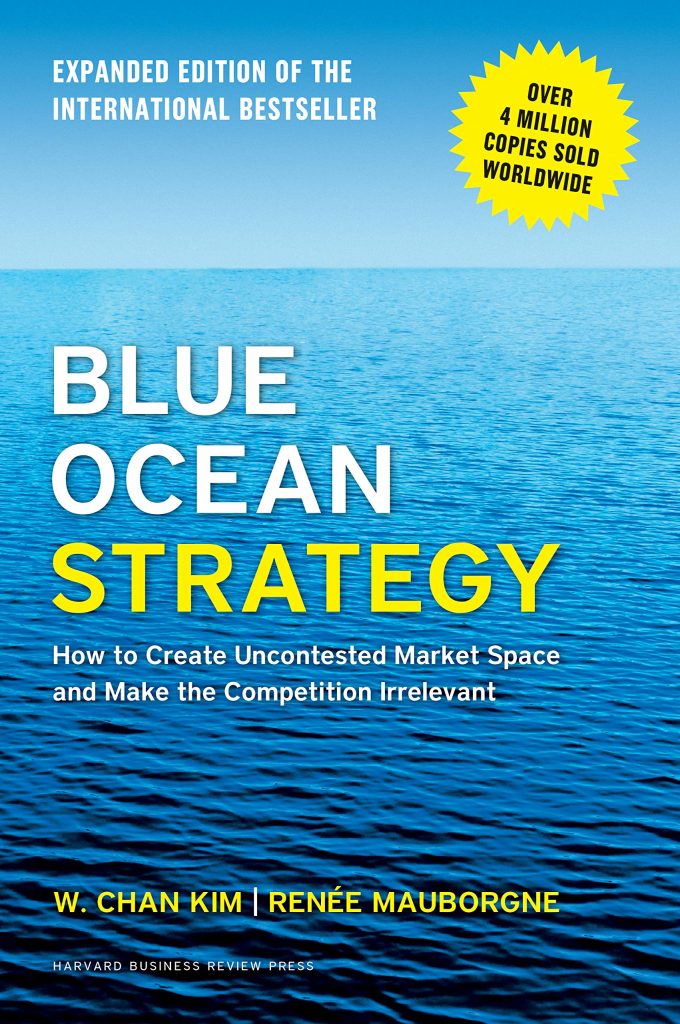
Since its first edition, Blue Ocean Strategy has been revised and expanded in 2015 and has become a bestseller with over 4 million copies sold in 46 languages.
The book is recognized as one of the most iconic and impactful strategy books ever written and is the recipient of numerous distinguished awards. Both authors received widespread recognition for their work in the form of various awards and distinctions.
Apart from their careers in academia, Chan and Renée have been employed in an advisory capacity by prestigious organizations. Kim is an advisory member for the European Union and serves as an advisor to several countries and Renée served on President Barack Obama’s Board of Advisors on Historically Black Colleges and Universities (HBCUs) for the president’s two terms.
In 2019, Thinkers50 named Chan Kim and Renée Mauborgne the #1 Business Thinkers in the World.

How to grow your business with 1 strategy framework
Differences between Red Ocean Strategy and Blue Ocean in business and leadership
In Blue Ocean Strategy, red ocean is a metaphor for the known market space encompassing all the industries in existence today. Remember the documentaries that showed the audience what happens when a large number of sharks feed at the same time, in the same place? It’s called a shark feeding frenzy event and it turns the ocean water red with the blood of the fish the sharks are feeding on.
Blue ocean is the metaphor for the unknown market space and all the industries that are not in existence today. It’s the unchartered land that courageous explorers venture in to discover unimaginable riches and opportunities.
- Red ocean strategy is about competition
- Blue ocean strategy is about creating new demand
- Red ocean strategy is a market-competing strategy where profit and growth decline while competition increases
- Blue ocean strategy is taking the opportunity to grow rapidly and profitably
- Red ocean strategy competes over customers
- Blue ocean strategy turn non-customers into customers
- Conventional leadership focuses on the cognitive and behavioural skills of leaders
- Blue ocean leadership focuses on actions and activities tied to market realities
- Conventional leadership has resulted in 87% global average in employee disengagement
- Blue ocean leadership’s goal is to unlock unrealized talent and energy in the organization fast and at low cost
3 Brands that have differentiated from the competition, generated new demand and found a new market
Cirque du Soleil

image source: Cirque du Soleil@Facebook
Founded in 1984 in Canada, Cirque du Soleil is an entertainment company and the largest contemporary circus producer in the world.
There’s circus in the company name but the performances are not your usual live animal children focused shows.
By taking out live animal acts from their performances and focusing on creating storyline-based shows with live music and amazing acrobats, Cirque du Soleil has created a new market space and new demand: circus entertainment for adults.
More than 180 million spectators have seen a Cirque du Soleil production since 1984 worldwide. The company generates annual revenue of approximately $1 billion and its creations have received numerous prizes and distinctions, including seven Primetime Emmy Awards and a star on the Hollywood Walk of Fame.
Uber & Airbnb
Both Uber and Airbnb are great examples of the blue ocean strategy.

Airbnb launched in 2008, Uber – one year later.
Although operating in the hospitality industry, Airbnb doesn’t own any property, it manages an online travel platform. By allowing homeowners to monetize their spaces and travellers to book them instead of hotels, Airbnb has found a new market, a big one.
The numbers speak for themselves: 7+ million listings worldwide, 2+ million people staying on Airbnb per night on average, 750+ million all-time Airbnb guest arrivals. In Q1 of 2019, Airbnb registered $9.4 billion in the total booking value.

Although Uber is operating in the people moving industry, it is not a taxi company, but a ridesharing service.
The latest stats say there are 21 million trips a day taken by 111 million monthly active platform consumers located in over 900 cities across 69 countries. In 2019, the company registered $65 billion in gross bookings across all platforms.
How to create a blue ocean for your company through value innovation
Value innovation is one of Blue Ocean Strategy’s tools and is defined as the simultaneous pursuit of differentiation and low cost, creating a leap in value for both buyers and the company.

10 questions to increase employee retention
The concept of Value Innovation is the cornerstone of the market-creating strategy.
Because value to buyers comes from the offering’s utility minus its price, and because value to the company is generated from the offering’s price minus its cost, value innovation is achieved only when the whole system of utility, price, and cost is aligned.
Chan Kim and Renee Mauborgne
But how does one achieve value innovation?
To achieve value innovation, the company looks at two factors: cost savings and buyer value.
The company makes cost savings by eliminating and reducing the factors an industry competes on and lifts buyer value by raising and creating elements the industry has never offered.
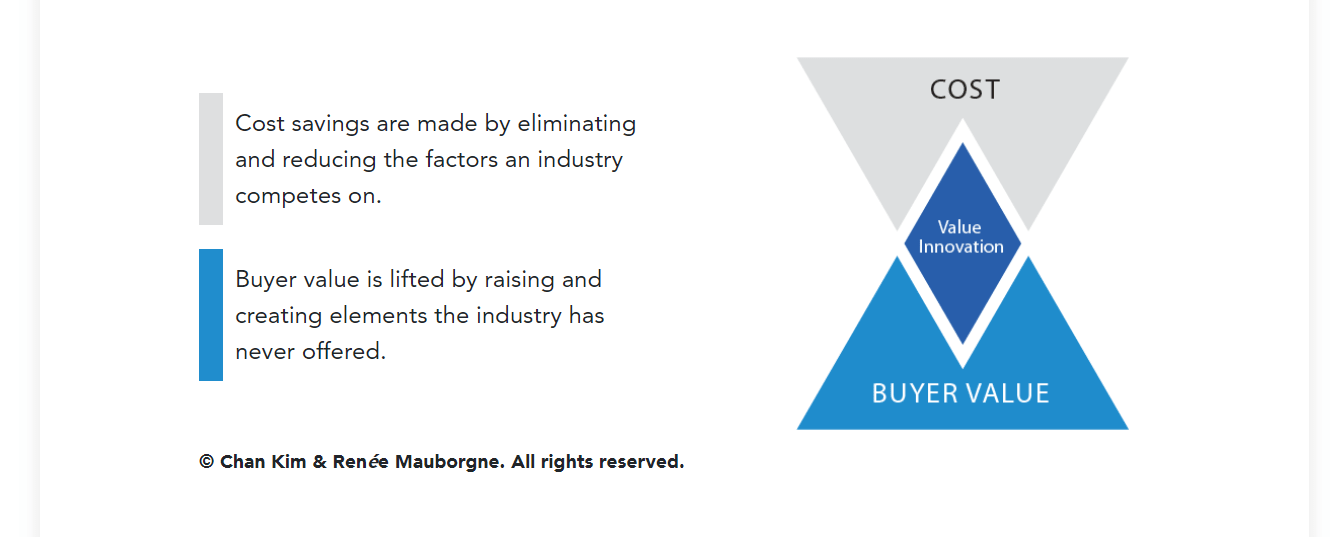
Many businesspeople believe that lowering costs and increasing value is a trade-off. It’s either creating greater value for customers at a higher cost or creating reasonable value at a lower cost. Blue Ocean Strategy allows companies to pursue differentiation and low cost simultaneously.
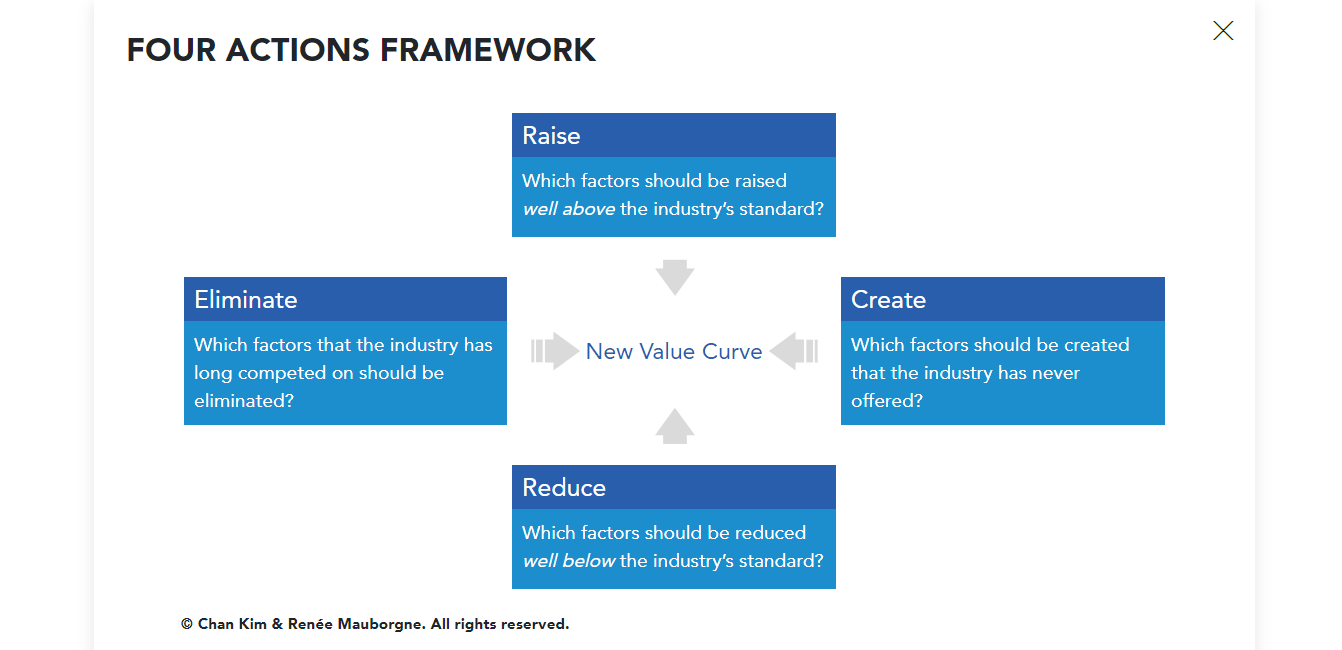
A great starting point for achieving value innovation is to answer the following questions devised by Chan Kim and Renee Mauborgne in the Four Actions Framework:
- Which of the factors that the industry takes for granted should be eliminated?
- Which factors should be reduced well below the industry’s standard?
- What factors should be raised well above the industry’s standard?
- What factors should be created that the industry has never offered?
In conclusion, to find your blue ocean, namely to tap into a new market, you need to perform an innovative leap in customer value at lower costs thus making the competition irrelevant.
Join the Conversation
We’d love to hear what you have to say.
Get in touch with us on our LinkedIn Group, Facebook Group or Twitter.
A New Year, A New Me – 7 Effective Steps To Achieve Growth in 2019
Picture your favorite tree. In order to grow tall and develop a rich and lush canopy, the tree needs strong roots.
It’s the same for your business. Your business’s development and ultimate success are linked to your own personal growth.
Growth is the conscious pursuit of expanding self-awareness, knowledge and improving personal skills.
Here are 7 effective steps to achieve growth in 2019:
1. Monitor your self-talk
According to Psychology Today, your self-talk combines your conscious thoughts with your unconscious beliefs and biases. It’s an effective way for your brain to interpret and process your daily experiences.
Acknowledge your self-talk and monitor it: what does it tell you?
Do you tell yourself you can’t do something, that you’re stupid, ugly or that you’re not good enough?
If you do, know you have a negative self-talk and you need to work on yourself to change it.
Is your negative self-talk self-grown or is it something that has been told to you repeatedly while growing up? If the latter is true, your negative and deprecating self-talk is not really yours so why carry someone else’s emotional problems? Let go! Seek professional support to help you get rid of your emotional burden.
Learn more about negative self-talk and how to improve your life:
Self-Awareness: 5 Tactics To Improve It
2. Improve your discipline by adopting a No. Excuses. Mindset
I’m tired…I don’t have any money… I’m too old to start a business of my own… It’s too cold outside to go running… I’m not ready…
Have you ever told yourself any of the above or something along the lines? Although you’ve set yourself on the path for achieving your goal, you find yourself making excuses for not doing the work you need to do.
Excuses are exits signs off the freeway of life. Every time you make an excuse you basically stop where you’re going and you’ve delayed that vision, that destination that you so anxiously wanted to get to. When you’re making excuses you’re exiting from your dream.
Johh Maxwell
Why do we make excuses?
The main reason is fear. Fear of failure, fear of the unknown, fear of changing our lives, fear of making mistakes while inertia and complacency get the better of us.
Do you want to stop making excuses?
Here’s one single argument that will surely drive you right back: regrets. Having regrets of not doing everything you could have done to reach your full potential is painful and emotionally tormenting.
This is the conclusion latest research has revealed: people regret not being all they could have been.
We have one life. Stop making excuses. Or else you will spend your twilight years feeling regret for not becoming the person you know you could have become if only you had tried.
[bctt tweet=”Growth takes time. It’s all on you. You may have people around you supporting your pursuit of growth, but you will do all the work.” username=”brand_minds”]
3. Read the right books. Educate yourself.
Once you have decided the area on which you need to grow (whether it’s improving your communication skills, soft skills, develop a particular ability or nurture your talent), make a list of all the books that can help you reach your goal.
The most successful entrepreneurs didn’t wait for school classes to teach them, they were self-taught. Elon Musk, Jan Koum and Stewart Butterfield learned how to program by reading books and manuals on the subject. All three of them are now running billion dollar tech companies.
[bctt tweet=”Growth is painful. Change is painful. But nothing is as painful as staying stuck where you do not belong. N. R. Narayana Murthy” username=”brand_minds”]
4. Exercise self-awareness
What is self-awareness? Search for an answer to this question on Google and you get 453 million results. It’s a huge number which shows high interest for this subject.
Here’s another interesting number: a 2011 report estimated that there are 8.7 million species on Earth. Out of which only eight have self-awareness. These species are: humans, bonobos, orangutans, dolphins, orcas, some elephants, magpies and trained pigeons.
You would think self-awareness is a common ability among humans, the most intelligent species on Earth. Actually as dr Tasha Eurich has discovered, self-awareness is on short supply.
Dr. Tasha Eurich is an organizational psychologist and executive coach, with a 15-year professional experience witnessing the power of self-awareness in leadership. Dr. Eurich found a surprising discrepancy between believing to be self-aware and actually being self-aware: even though most people believe they are self-aware, only 10-15% of the people we studied actually fit the criteria.
To achieve growth in the area of your choosing, you need first to know and understand your own self.
Self-awareness gives us power. We might not always like what we see, but there’s a comfort in knowing ourselves. There’s a ton of research showing that people who are self-aware are more fulfilled, they have stronger relationships, they’re more creative, they’re more confident and better communicators. They’re less likely to lie, cheat and steal; they perform better at work and they’re more promotable. And they’re more effective leaders with more profitable companies.
Dr. Tasha Eurich
Listen to Dr. Eurich talking about how you can increase your self-awareness with one simple fix:
5. Learn to set goals correctly
In his book, The Motivation Myth, author Jeff Haden shows that motivation is not the secret ingredient of success. In fact motivation is a result of the process which leads to success, not the cause. The path to success is not paved with motivation, but with goals. Only not everyone knows how to set goals correctly.
Here is how to set goals in order to achieve growth successfully according to Jeff Haden via his article:
- Make your goal tangible, specific and easily measurable;
- Make your goal meaningful to you, not to others;
- Make your goal a positive goal;
- Focus on the daily process.
[bctt tweet=”Growth is never by mere chance; it is the result of forces working together. James Cash Penney” username=”brand_minds”]
6. Discover mentors online and connect with them offline
[bctt tweet=”If you ask any successful businessperson, they will always (say they) have had a great mentor at some point along the road. Sir Richard Branson” username=”brand_minds”]
We grow faster and become successful when we receive support and guidance from a more experienced person. Sometimes we cannot find the answer to our questions in books so a mentorship is the best solution.
Sir Richard Branson had Sir Freddie Laker, the entrepreneurs who revolutionized the airline industry by offering the first low-cost commercial transatlantic flights to guide him through rough times at Virgin Atlantic. The relationship between Bill Gates and Warren Buffett is well-known and both of them learned from each other. Mark Zuckerberg turned to Steve Jobs for advice on how to build the best team capable of changing the world.
There is a lot of information on how to choose the best mentor for your needs and where to find this mentor. You can also learn how to approach your chosen mentor and how to build a great relationship. You can start looking on LinkedIn or dedicated resources such as micromentor.org or going to industry events and conferences. You may not find your mentor tomorrow, but hang in there, my young padawan! If you are resilient you will find your Yoda.
Another way to grow is to become member of a mastermind group.
Napoleon Hill introduced the concept of mastermind groups in his 1937 book Think and Grow Rich. Mastermind groups are peer-to-peer groups whose members support, teach and help each other grow and solve problems. The appropriate mastermind group is very powerful and can take you to the next level.
Here are 5 benefits you can take advantage of when joining a mastermind group:
- High quality experience and knowledge;
- Support and advice provided by the group’s members;
- Collaboration between each of the group’s members;
- Extended network;
- New opportunities for business and for learning;
- No one is alone and we all grow faster with a little help from our peers.
[bctt tweet=”Surround yourself with people who are going to lift you higher. Oprah Winfrey” username=”brand_minds”]
7. Come to BRAND MINDS 2019 – The Central and Eastern-European Business Summit of the Year
If I were to compare BRAND MINDS to anything it would definitely be a famous rock band concert – packed venue, excellent performance on stage, everyone breathing in unison.
At the 2018 event we had 3000 attendees: professionals, high profile CEOs, media and online personalities. It was a huge experience for everyone attending the business conference. Every speaker gave 120%: they provided knowledge, actionable information, inspiration, laughter and answers to questions.
Ever since the first event six years ago, BRAND MINDS is focused on delivering the best growth experience to its attendees.
BRAND MINDS 2019 is certainly fitting this description. Our speakers are world-renowned experts in their fields: Yuval Noah Harari, Guy Kawasaki, Brene Brown, Robert Cialdini, Grand Cardone and Hitendra Wadhwa.
Make 2019 the year of your growth!
Join the Conversation
We’d love to hear what you have to say.
Get in touch with us on Facebook and Twitter.
Growth Story: How Canva Acquired 10 Million Users within 5 Years
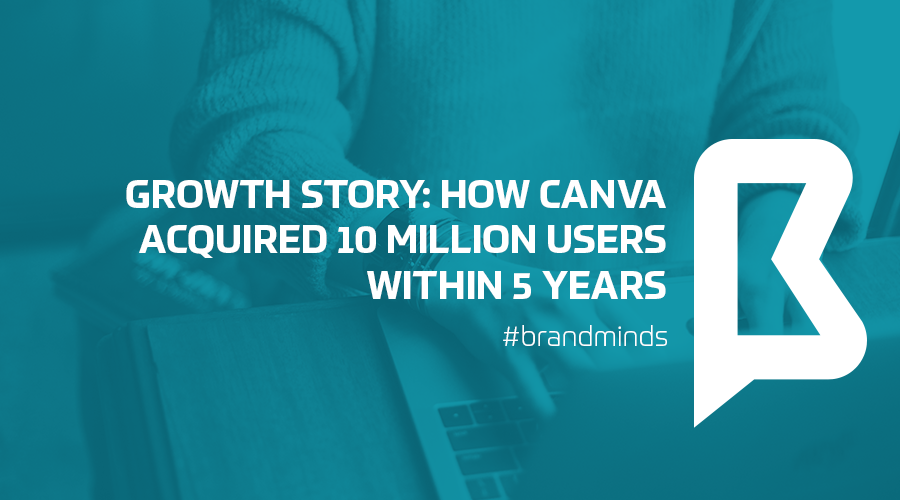
There are 2 billion people on Facebook, 1 billion on Instagram and 500 million on LinkedIn. They use images to communicate and connect on all of these platforms but they are not photographers.
There are over 70 billion businesses using Facebook Pages, 25 million business profiles on Instagram and 18 million company pages on LinkedIn. Businesses hire social media managers to craft their presence and communicate with their followers. Although they are not graphic designers, their employers require them to have image designing abilities. Photoshop and Adobe are tools designed for professional graphic designers, but they are difficult to use by noobs.
What can individuals as well as communication professionals do beside going to graphic designing school?
They use Canva.
Our goal is to enable the whole world to design.
Melanie Perkins, CEO of Canva
Canva provides graphic design software as a service; it is an online collaborative platform dedicated to people who aren’t graphic designers and don’t have funds to hire one for their various needs.

Canva’s tools are simple and very easy to use, its interface is user-friendly and intuitive. The user is provided with a wide range of templates, fonts, colors and free photos to choose from. From Facebook covers to Instagram posts, brochures, infographics, logos, wedding programs etc – you can design anything and the end result looks amazing. Canva makes its users feel empowered to design and let their imagination translate into beautiful visual imagery and graphics.

Cliff Obrecht, Melanie Perkins and Cameron Adams/canva.com
Canva by numbers
Co-founders Melanie Perkins, Cliff Obrecht and tech expert Cameron Adams launched Canva in 2012 to selected professionals.
By January 2014, Canva had 150,000 users and opened publicly.
In April 2014 Guy Kawasaki joined the team as Canva’s Chief Evangelist; two months later the number of users tripled.
By October 2014 there were 1 million users who shared their Canva-designed images on social media, blogs, emails.
In August 2015, Canva announced it has reached 4 million users.
In 2017 the Australian startup reached profitability thanks to 294,000 paying customers.
To date, the do-it-yourself design platform has more than 10 million users across 179 countries with more than 100 million designs.
Canva’s founders raised $86 million since its launch and the company is currently valued at $1 billion.
Canva’s goal is to raise its users number to 3.2 billion (according to techcrunch.com).
- +10 million users
- +100 million designs
- 3 offices
- 200 team members
- $1 billion value
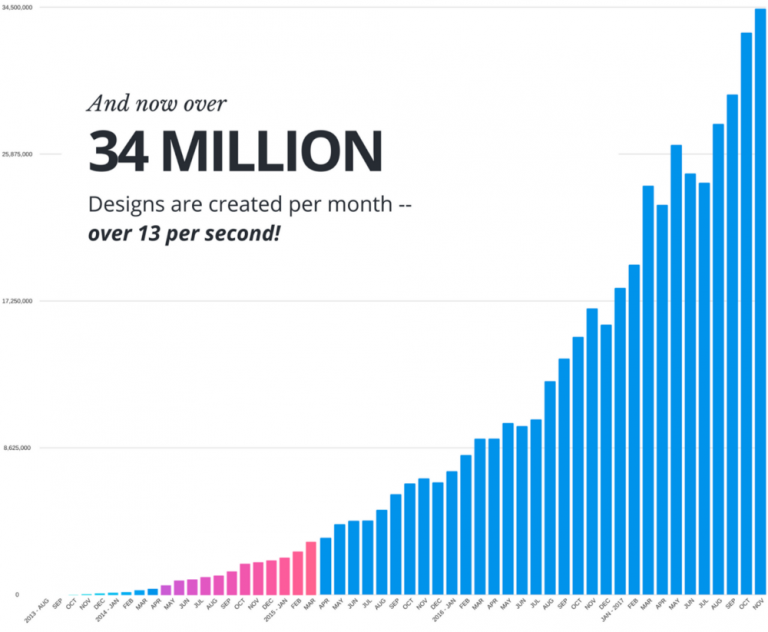
medium.com
Main reason for Canva’s success – a product which solves a problem people care about
While studying at the University of Western Australia, Melanie was teaching students how to use mainstream design software like inDesign and Photoshop, programs that people found hard to learn and even harder to use. She told bbc.com that “It could take a whole semester to learn the very basics. Even the simplest tasks, like exporting a high-quality PDF file, could take 22 clicks.”
You want to make sure that the solution you create, solves a problem that people care about. Find something that is truly significant. Find a problem faced by lots of people.
Melanie Perkins via forbes.com
She became aware she had just stumbled upon a business opportunity – the market needed a much simpler design tool and she was going to develop it. Melanie took her boyfriend Cliff on board and together started Fusion Books, an online design tool that made it easier for students and teachers to create their own yearbook. Fusion Books was a success, but Melanie and Cliff realised that the technology they had developed could be used much more broadly. They recruited Cameron Adams, Canva’s tech co-founder and the three of them began building Canva.
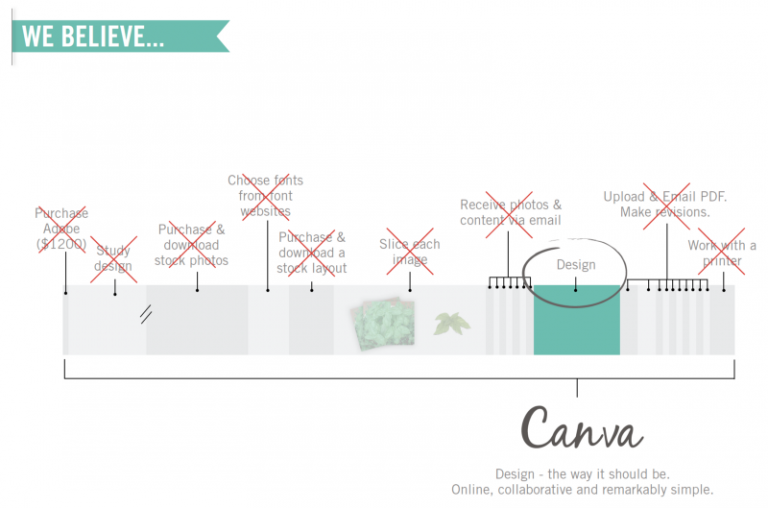
medium.com
4 strategies which supported Canva’s exponential growth
Canva never used paid advertising to tell prospects about its tool. The team developing Canva chose a different approach to grow the company.
1. Developing a great product, listening to user feedback and testing over and over again
Melanie and her team developed a good product but they postponed Canva’s launch to the public until they had a great product. After many months of continually refining, improving and testing the tools, they realised it’s not all about the digital tools, but also about empowering the users. Here is Melanie writing in her article about this moment:
It became quickly apparent that it was not just the tools themselves that were preventing people from creating great designs, but also people’s own belief that they can’t design.
In order for Canva to take off — we had to get every person who came into our product to have a great experience in a couple of minutes.
We needed to change their own self belief about their design abilities, we needed to give them design needs and we needed to make them feel happy and confident clicking around. We needed to get them to explore and play in Canva. No short order! So we spent months perfecting the onboarding experience paying particular attention to users’ emotional journey.
2. Word of mouth advertising and social currency
The 50,000 subscribers to Canva’s waiting list talked first about this amazing online design tool; this attracted early adopters, the first 150,000 people using Canva tools. These early adopters became Canva’s advertising engine by sharing their designs with their friends. Canva grew at a fast pace all through word of mouth and social proof.
Social currency in the sense of our community has always been incredibly valuable for us. More than 10 million people use Canva in 179 countries, and much of that growth has come through word of mouth and our users sharing about us.
Melanie Perkins via forbes.com
3. Influencer Advocacy
Guy Kawasaki learned about Canva through one member of his social media team who was using Canva to create graphics for his posts. When the people at Canva noticed Guy’s social media graphics were designed with their tools, they contacted him and so he became Chief Evangelist of Canva.
The reason Guy was attracted to Canva was that it “could democratise design just as Apple democratised computers and Google democratised information”. Guy Kawasaki coming to Canva and supporting it helped the online design platform double its users numbers.

Guy Kawasaki, Melanie Perkins and Cliff Obrecht/canva.com
4. Empowering content
Besides developing cool digital tools to support users craft wonderful graphics, Canva also empowers its users by helping them improve their designing skills.
Design School is Canva’s knowledge blog, the place where beginners and professionals come for design tips and inspiration. The blog is rich in resources such as tutorials and articles on how to design a brand, how to be more creative, what are the best resume or email templates etc.
One particular article, Benefits of Walking: Why the Greatest Minds take the Longest Walks, went viral with 90.5k shares on Facebook, 5.9k shares on Twitter and 2.4k shares on LinkedIn.
Did you like our article?
Share it with your friends!
5 Business Growth Secrets from Successful Entrepreneurs
One of the questions that most entrepreneurs ask is What drives business growth?
To help you grow your business, we put together the following list:
5 business growth secrets from successful entrepreneurs
Business growth secret #1 – Continuous learning

Grant Cardone/wallstreetoasis.com
At 23 Grant Cardone was a car salesman struggling with a drug addiction. He was a poor salesman, making only $300 a month. After getting clean of his drug addiction, he decided to become the best salesman though he didn’t like selling cars. To achieve his goal, he went all in. He spent all of his free time studying every sales book, sales training tape or sales course there was on the market at that time. He studied all the sales masters to learn everything he could. Every book, every line, and every piece of information – he turned them around and made them his own. He lived and breathed sales.
Within three years he was in top 1% of everybody in the automobile industry. He became a sales master at 29 years old. He was teaching other people about sales while actively doing sales every day.
In his fifties Grant Cardone is the best sales training expert in the world. He owns multiple successful companies whose annual revenues exceed $100 million.
Grand Cardone will be speaking at Brand Minds 2019, the Central and Eastern European Business Summit of the Year, on May 10th, in Bucharest.
Key takeaway: Find your subject of interest and go deep.
Business growth secret #2 – Get used to failing
What do all successful entrepreneurs have in common? It’s not their IQ, it’s not their talent or having lots of money. It’s grit.
Grit is a personal quality defined as perseverance and passion for long-term goals. Grit entails working with great effort and determination toward challenges. Another feature of grit is the ability to maintain effort and interest over years despite failure, adversity and plateaus in progress.
When people experience disappointments or boredom in their entrepreneurial endeavours, most of them change direction or abandon altogether. Unlike them, the gritty individuals stay the course. Think Elon Musk, Steve Jobs and Jack Ma: faced with one failure after another, they didn’t surrender, they kept going for their dreams.
Find more about grit in our article This is the no 1 trait that predicts entrepreneurial success.
Key takeaway:
Reframe your failure and learn from it. All entrepreneurs make mistakes but only few are mentally strong to get back up and keep going.
Business growth secret #3 – Experiment
Have you heard of the 10,000-hour rule that states one needs to practise for 10,000 hours to become an expert? This rule of thumb holds true in domains such as games, music and sports, but it isn’t valid in business.
What helps businesses scale up is experimentation. This is Mark Zuckerberg’s strategy to grow Facebook: he replaced the 10,000-hour rule with the 10,000-experiment rule (source: entrepreneur.com)
The 10,000-experiment rule stems from science. At the core of any scientific development lies experimentation: develop a hypothesis, perform a test to prove the hypothesis right or wrong, analyse the results, and create a new hypothesis based on what you learned.
Giant tech companies have been developing fast and the driving force behind their achievements is the scientific method of experimentation. Learn more about the 10,000-experiment rule here.
Key takeaway:
Devise multiple small experiments and run them every day. Analyse the results, draw conclusions and apply them to your next experiment. This process will ensure constant improvement of your results and with each experiment you will get closer to achieving your goal.
Business growth secret #4 – Grow a positive company culture
In 1998 Nokia became the best-selling mobile phone brand in the world. By 2013 Nokia lost it all and was acquired by Microsoft. There were many reasons for Nokia’s demise but one reason stands out: Nokia people weakened Nokia people.
A 2015 research paper found that the giant manufacturer’s culture of status has made the company ill with organisational fear. The human factor was added to economic and structural factors and together they have generated a state of “temporal myopia” that hindered Nokia’s ability to innovate.
Employees stated that top managers and directors were no longer abiding by Nokia’s core values of Respect, Challenge, Achievement and Renewal (for more in-depth analysis read our article Why did Nokia fail?).
Microsoft learned from Nokia’s mistakes and changed its culture when Satya Nadella became the CEO of Microsoft in 2014.
Satya Nadella says his job as CEO is to create a culture that focuses on listening, learning, and harnessing individual passions and talents. At the core of Microsoft’s culture is employer empowerment.
Key takeaway:
Company culture starts at the top and grows at the bottom. Leaders must embody the company’s values and be role models for their employees.
Business growth secret #5 – Develop your network

Business networking is possibly one of the most important soft skills for entrepreneurs. It is the main activity that drives business growth.
Your main goal is to become a magnet, which attracts people and resources: money, ideas, opportunities, information etc. What does it take to become a magnet? Invest your time and energy to develop a strong network of contacts.
Do you need help to network correctly and efficiently? Read our article: 5 tips for successful business networking.
Key takeaway:
Remember that networking is not about selling. Business networking is about offering advice and helpful insights and building authentic relationships.
Expert’s opinion
Peter Barta, CEO of FPP and mentor at The Founder Institute is sharing with us his perspective on what it takes for an entrepreneur to be successful:
Starting a new venture is a very challenging process. Few of new initiatives end up being successful companies.
There is a saying Good ideas are a dime a dozen. What is the meaning of it? It means the value in any business is in implementation, and successful implementation is a mix of ingredients like vision, drive, confidence, flexibility, communication skills, multitasking, optimism. If you mix them together in the right way, it will lead to a successful company.
Running a business is like running a marathon with highs and lows, and what is coming can be exciting and scary in the same time. In order to maximise your chances you need to be clear on what your strengths and weaknesses are.
One of the things that strikes me when I talk to wannabe entrepreneurs is they can’t answer basic questions like:
What’s your reason for starting a business?
Most of the answers fall under these:
I want to be rich.
I don’t want to have a boss.
I had a fight with my former boss and so on.
All of these answers are not enough to drive your motivation in building a company. Sometimes I’m asking them if they are willing to run the extra mile in order to succeed, and the most obvious answer I get is What do you mean by that? I start to add:
Are you willing to learn?
How about failing?
How about experimenting?
What I found the most difficult are things related to experimentation and failing. Why? Culturally speaking we are not used to getting out of our comfort zone. We feel insecure and that’s okay because we don’t know what is out there, what is expecting us. The same with failing.
Unfortunately fear of failing is embedded in our DNA. We tend to see this as something bad. What we can do instead is we can look at it as being a learning process, a simple experimentation that didn’t get us the results we wanted.
One ingredient that I was mentioning above is optimism. This means when things don’t go in a way you expected and you failed, you recognise that you are not a failure, but the strategy or product that you were working on were not right.
3 Growth Hacks Spotify uses in Brand Strategy
How did Spotify use growth hacks in their brand strategy?
Spotify Technology SA is a Swedish entertainment company founded by Daniel Ek and Martin Lorentzon. They launched their music, podcast, and video streaming service on 7 October 2008. The company’s title is a combination of “spot” and “identify”.

image source: spotify.com
Spotify by numbers
Spotify is currently available in 65 countries all over the world and provides access to more than 35 million songs.
Spotify is a freemium service: it offers free basic features with advertisements or limitations, while additional features, such as improved streaming quality and music downloads, are offered via paid subscriptions.
On February 2018, the Swedish program went public on the New York Stock Exchange and its shares began trading on April 2018.
As of 2018, Spotify has 170 million active users, including over 75 million paying subscribers.
image source: techcrunch.com
Main reason for success – a disruptive product
On the music market, at the moment Spotify was launched, there were other products but they didn’t cater to market’s needs for music streaming services.
Spotify’s Unique Value Proposition was to give users complete control and access to any song, on demand, for just $10/month, along with a free option that offered more than simple radio-style streaming—not to mention the fact that it was totally legal.
It was an instant success because it filled a market gap.
Spotify revolutionized the way people listened to music. It became popular with music streaming services consumers because it puts the control firmly in the user’s hands, allowing them to select specific songs and create playlists.
Spotify is interactive
One of its features decreased the friction of adoption: it allowed users to upload local tracks so they don’t have to leave their own libraries and playlists behind in order to make the switch to Spotify.
Spotify filled the need for consumers but was able to control its growth.
Rolled-out with an invite-only system which helped the company generate buzz and increase demand through perceived scarcity.
Spotify attracted the tech-loving early adopters.
It integrates with today’s shareable world: it’s easy to share because each track, album and playlist has a unique URL. And it also caters to users’ need to share the music with his/her friends on social platforms.
Here are 3 growth hacks Spotify uses in brand strategy
Partner Up – Spotify & Starbucks
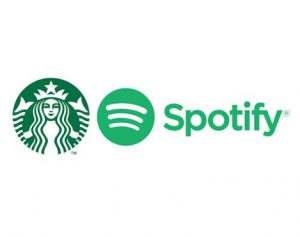
image source: news.starbucks.com
In 2016 Starbucks and Spotify became partners.
The goal of this partnership was to drive listenership to the streaming service and allow the chain coffee shops’ customers to easily engage with music played at its 7,500 locations.
Through the Starbucks app, via location sharing, customers were able to favorite and add the music playing during a visit to a store. They were also able to influence Starbucks’ future in-store playlists. Spotify’s streaming became integrated with the beverage brand’s popular mobile loyalty program, My Starbucks Rewards. My Starbucks Rewards and Spotify users earned “stars as currency” for subscribing to Spotify Premium. Customers who purchased Spotify’s streaming packages were also eligible to earn more rewards points, which could have been redeemed for free beverages.
Piggyback on a thriving network – Spotify & Facebook Messenger

image source: techcrunch.com
In 2016, Spotify integrated with Facebook Messenger allowing people to share their Spotify songs or playlists directly within a chat box. Because each track, album and playlist has a unique URL, Spotify is sharing-friendly.
This integration accelerated Spotify’s growth through referral traffic. Ultimately, millions of Facebook users also became advocates of the music platform because it filled the users’ desire to share their music socially.
Data driven & User-Generated Content
‘Thanks 2016, it’s been weird”
Using their data insights about users’ listening habits, Spotify put together their best ad campaign so far.
The campaign is called Thanks 2016, it’s been weird, it was released on October 2016 and featured outdoor billboards containing funny messages based on the weird, wonderful and emotional playlists Spotify users had created.
During the course of the campaign’s run, Spotify subscription growth easily broke all company records. The increase in monthly active users exceeded targets, with over 1 billion streams directly attributed to the campaign, and over half a million reactivated users.
The central focus of the campaign was customisation: Spotify wanted to re-state the freedom users have to mix up their playlists and get creative.
Did you like our article?
Subscribe to our newsletter so you can receive our content!
Will Twitter rise up in 2018?
As in the last years Facebook took the face off Twitter, specialists started to wonder if Twitter isn’t close to taking MySpace’s road and die. and many were starting to believe that will be the reality. But, in fact, the end of 2017 and 2018’s start show a revival of the social media platform.
“Twitter stock has been on fire, soaring some 16% in the past five days, including an 11% surge on Monday, thanks to a major endorsement from J.P. Morgan analyst Doug Anmuth, who named Twitter among the firm’s best stock ideas for 2018. Investors wasted no time buying into the idea that Twitter’s worst days are behind it,” wrote Richard Saintvilus for Nasdaq at the end of December 2017.

The company’s improved live-streaming capabilities is one of several factors Anmuth sees as increasing Twitter’s growth, including an expected 10% increase in daily active user growth in 2018 and an advertising revenue growth greater than 8 percent. Moreover, he expects the company to be profitable in 2018, which would mark a significant leap in the company’s investment profile.
“We believe both the TWTR story and financial results will strengthen over the next year as the company continues to build on its differentiated value proposition for users & returns to revenue growth,” wrote Doug Anmuth,quoted by CNBC.
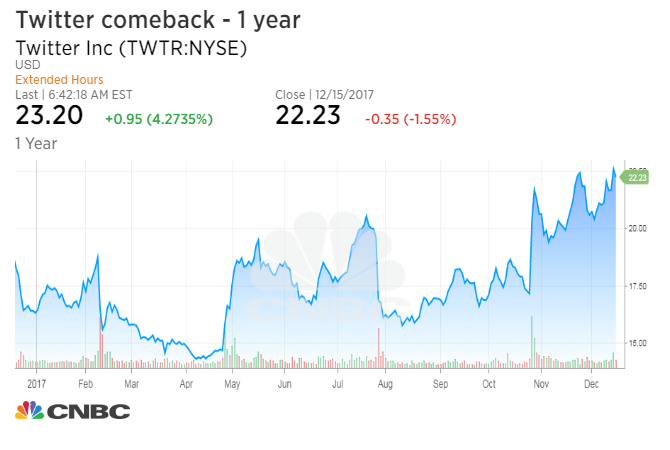
Moreover, according to MarketWatch, Bloomberg is bringing a news network to Twitter, in partnership with heavyweights including Goldman Sachs, Infiniti and AT&T. That is a great marriage between content and advertisers, proving the platform has a bigger monetization strategy than just random sponsored tweets. Twitter also launched pre-roll ads that can play before livestreams on its Periscope video platform. More recently, the company has started offering a more accessible way for developers to tap into content and data on its platform. There have also been rumors of a paid-subscription service on Tweetdeck for its most loyal and devoted users.
How to inspire innovation in your employees
According to McKinsey & Company and its global innovation survey, innovation is critical to growth, particularly as the speed of business cycles continues to increase. Most companies understand the importance of innovation, but fall short when it comes to execution. “We define innovation as creativity plus delivery, helping our clients transform their innovation performance by focusing on four requirements for innovating at scale: strategy, pipeline of ideas, execution, and organization.”
Following a multiyear study comprising in-depth interviews, workshops, and surveys of more than 2,500 executives in over 300 companies, including both performance leaders and laggards, in a broad set of industries and countries, the company discovered the ingredients that lead to innovation.
Since innovation is a complex, company-wide endeavor, it requires a set of crosscutting practices and processes to structure, organize, and encourage it. The first four, which are strategic and creative in nature, help set and prioritize the terms and conditions under which innovation is more likely to thrive. The next four essentials deal with how to deliver and organize for innovation repeatedly over time and with enough value to contribute meaningfully to overall performance.
Who are those essentials? Aspire,Choose, Discover,Evolve,Accelerate, Scale, Extend, Mobilize.
Even there is no proven formula for success, particularly when it comes to innovation, McKinsey & Company’s representatives firmly believe that if companies assimilate and apply these essentials—in their own way, in accordance with their particular context, capabilities, organizational culture, and appetite for risk—they will improve the likelihood that they, too, can rekindle the lost spark of innovation. In the digital age, the pace of change has gone into hyperspeed, so companies must get these strategic, creative, executional, and organizational factors right to innovate successfully.
One can read more on the subject here.
How this transfer to the employees? According to Forbes, there are three tools that can inspire innovation to the employees: giving employees the permission to learn, motivating people to go places they wouldn’t otherwise go and sharing experiences across management lines. “Asking employees to keep a Best Practice Journal is another way to inspire employees to learn by observing what’s happening around them. Ask your people to document examples of great performance as they see it happening out in the world and make time for sharing these observations at regular staff meetings,” added Mark Murphy for Forbes.
Another set of great ideas may be found here.
The huge power and potential of Snapchat
Launched in July 2011, by three Stanford University students (Evan Spiegel, Reggie Brown and Bobby Murphy), Snapchat went from being an application created for a University project to one of the biggest social media sensations in the recent years. First launched under the name Picaboo, the app received a re-launch and a rebranding and became the Snapchat that we all know and love.
The social media platform has grown immensely in popularity over the last 4 years and has now become one of the biggest social media platforms of this time. With over 100 million daily users worldwide, the app attracts especially Millennials and youngsters, but also a lot of celebrities. Therefore, the brands are “lining-up” and doing their best to attract the users’ interest and likeability. Moreover, Snapchat has grown as a marketing tool since brands have found it effective for promoting to a younger demographic group that they eagerly want to reach.
Part of the social media platform that attracted the most the users is the fact that people seem to be more genuine on it, even the celebrities, showing real moments of their lives, uncut behind-the-scene snaps, sexy and funny videos. Everyone from models to actresses (to model/actresses, to model/DJs, you get the idea) are daily users (DJ Khaled and Kylie Jenner just might be addicted) and now, some are even using the platform to premiere and share original content. You can find here a list of the celebrities that love the social media platform, you will for sure have the chance to see some of your favorite ones. As of February 2015, more than 60% of 13-to-34-year-olds had the app downloaded on their phone, according to a U.S. Census study on Snapchat’s site, even the White House having an account.
Also, as proved by several studies, more Americans are familiar with Snapchat than with Pinterest or Linkedin (not to mention Tumblr, Vine, etc), having more users than Twitter or Pinterest or Linkedin. In the past 12 months, awareness of Snapchat among Americans 12 and older grew from 60% to 71%, with the platform growing in one year as much as Twitter has in 4 years combined. In the 2013 Infinite Dial study, 15% of Americans said they used Twitter. By 2016 21% of the country claimed Twitter usage. Between 2015 and 2016, Snapchat went from 17% to 23%. Looking at all those figures, it’s no wonder that Snapchat is considered to be USA’s second-favorite social network, with 26% of Americans citing Snapchat as the place they visit most. Instagram is third at 17%, in the Infinite Dial’s 2016 study. First place is still held by Facebook, with 32% saying they use it most. This is a big move in just one year, as the previous edition of The Infinite Dial showed Facebook at 43%, Instagram in second place at 18%, and Snapchat at 15%. Essentially, what has happened is that in 12 months, 10% of the entire nation’s population of social media using 12-24 year-olds moved from Facebook to Snapchat as their platform of choice.
In this context, there is no wonder that, according to Re/code, advertisements and marketing videos on the service alone are seen between 500,000 and a million times a day.
Much of Snapchat’s surge in usage has been attributed to the app’s Stories and Discover features. People are able to connect with new brands and influencers that might have previously been outside their normal spheres of interaction and the stories the people behind those accounts create – visual tales like behind-the-scenes footage or brand messaging, for instance – build instant connections between companies and consumers.
According to Forbes, Snapchat has more than 60 million users in the U.S. and Canada alone. Snapchat was set to rake in about $ 366.7 million in ad money in 2016 and they’re poised to break the $1 billion-mark in 2017. A lot of that money is coming from the full-screen ads strewn across those Stories and Discover sections.
The reason for the huge potential of Snapchat Advertising
Whether you are representing a small, medium or big brand, if you are targeting Millennials and youngsters, you must be on Snapchat. Try and learn from the brands that have already pathed the way for you. Take the best you can, try and innovate and, most of all, be present. If it’s something we’ve all learned through the social media boom is that being up-to-date with the changes and keeping an eye open are two essential factors in the success of the brands. And also, try to do at least a little bit of real-time marketing. Snapchat is the real place for it. The app others the marketers several big reasons for being there:
Frequency: Once a snap disappears it’s time to put up another one – that steady stream of content helps build rapport and frames the brand as reliable and communicative
Approachability: Many brands and personalities have found success posting raw footage that gives audiences a glimpse behind the curtain – from pre-concert footage from musical acts to touring a new pop-up store with a fashion designer, these sneak peeks build interest.
Story-First Focus: Most social platforms run off of “likes” or favorites that advertisers feel driven to accumulate. Snapchat advertising ditches that kind of approval, in favor of more organic storytelling that feels more authentic.
Getting more personal: Closer than ever to your favorite stars. What more can a fan want?
The fun / ironic side of it: We all want to have a good time and be entertained. And Snaptchat sure knows how to do it.
The best local brands that went global
The world’s largest brands are facing a dual threat from slowing growth in developed economies and the rising popularity of homegrown brands. As getting more sales from existing customers becomes increasingly difficult, and costly, brands are turning their attention to the places where they can attract new customers – emerging markets. According to Kantar Worldpanel’s fifth annual Brand Footprint study, emerging markets now account for 51% of global spend on fast-moving-consumer-goods (FMCG), up from 48% just three years ago. Emerging countries added $34 billion to the global industry throughout the year, a gain of more than 6% over last year, while sales in developed markets were flat. This year’s ranking analyzed 15,300 brands and 1 billion households in 43 countries across five continents in the 12 months to November 2016.
Looking to go global? Join this masterclass!

“The underlying theme of this year’s report is disruption,” said Josep Montserrat, chief executive officer of Kantar Worldpanel. “This not only relates to the political and economic climate of today, but also to the increasing number of disruptor brands and trends which are upsetting the status quo.”
While global brands remain dominant, local brands are achieving faster growth. Local brands grew by 3.9% in 2016, compared with 2.6% growth for global brands.
“In 2016, the price gap between global and local brands has narrowed to the point of disappearing,” said the report. “No longer does being a global brand automatically command a price premium. Global brand owners are having to work harder to convince consumer that a global choice offers the additional reassurance of quality and confers prestige.”
Local brands claimed the top spot in more than half of the countries studied by Brand Footprint. Some of these brands represent a more affordable option in struggling economies like Brazil and Argentina. However, in developed markets consumers have shown they are willing to pay a premium for homegrown products. Local brands are seeing the strongest performance in the food and beverage categories, while health and beauty brands continue to be driven by global brands.
Becoming a successful global brand requires an understanding of local cultures, lifestyles and ideologies, according to two industry figures. In a WARC Best Practice paper, How global brands resonate across cultures, Sue Mizera and Alessandra Cotugno, senior executives at Young & Rubicam, observe that the standardization of brand name, logo, image, packaging and brand positioning simply enables brand recognition in multiple markets. Moreover, different brand values emerge as more important in different countries: Germans like the notion of directness, for example, while Indonesians prefer kindness and South Koreans favor energetic brands.
Here are five great local brands that are worldwide global successes:

- IKEA
In the 1980s, IKEA expands dramatically into new markets such as USA, Italy, France and the UK., the brand beginning to take the form of today’s modern IKEA. In the 2000s, IKEA expands into even more markets such as Japan and Russia. This period also sees the successes of several partnerships regarding social and environmental projects. Today is a major retail experience in 40 countries/territories around the world.
Marcus and Sam commissioned a fleet of steamers to carry oil in bulk, using for the first time the Suez Canal. They also set up bulk oil storage at ports in the Far East and contracted with Bnito, a Russian group of producers controlled by the Rothschilds, for the long-term supply of kerosene.
Their strategy was high-risk: if news of their operations got out they would be squeezed out by Rockefeller’s dominant Standard Oil. With the maiden voyage of the first bulk tanker, the “Murex”, through the Suez Canal in 1892 the Samuels had achieved a revolution in oil transportation. Bulk transport substantially cut the cost of oil by enormously increasing the volume that could be carried. The Samuel brothers initially called their company The Tank Syndicate but in 1897 renamed it the Shell Transport and Trading Company.
In 1907 the company merged with Royal Dutch Petroleum Company, becoming The Royal Dutch Shell Group. There were two separate holding companies with Royal Dutch taking 60% of earnings and Shell Transport taking 40%. The business was run by a variety of operating companies. The merger transformed the fortunes of both companies. Under the management of Henry Deterding they turned from struggling entities to successful enterprises within twelve months.
The Group rapidly expanded across the world. Marketing companies were formed throughout Europe and in many parts of Asia. Exploration and production began in Russia, Romania, Venezuela, Mexico and the United States. The first twelve years also provided many exciting opportunities to demonstrate the quality of the products in the new, fast-developing market for gasoline. These included record-breaking races, flights and journeys of exploration.
More on the history you can read here.
3. Nestlé
The company history begins in 1866, with the foundation of the Anglo-Swiss Condensed Milk Company. Henri Nestlé develops a breakthrough infant food in 1867 and in 1905 the company he founded merges with Anglo-Swiss, to form what is now known as the Nestlé Group. During this period cities grow and railways and steamships bring down commodity costs, spurring international trade in consumer goods. In 1904, Nestlé begins selling chocolate for the first time when it takes over export sales for Peter & Kohler. Henri Nestlé himself plays a key role in the development of milk chocolate from 1875, when he supplies his Vevey neighbour Daniel Peter with condensed milk, which Peter uses to develop the first such commercial product in the 1880s.
In 1960, with increasing numbers of households buying freezers, demand for ice cream is rising. Nestlé buys German producer Jopa and French manufacture Heudebert-Gervais to capitalise on this growth, and adds Swiss brand Frisco in 1962. The company also buys UK canned foods company Crosse & Blackwell. In 1961, Nestlé buys the Findus frozen food brand from Swedish manufacturer Marabou, and extends the brand to international markets. Findus is one of the first companies to sell frozen foods in Europe, from 1945. As chilled dairy products are increasingly popular, Nestlé buys French yogurt producer Chambourcy. In the early 1970s the latter launches the Sveltesse range of yoghurts, aimed at health- and weight-conscious consumers.
Moreover, 1969 is the year the company enters on the mineral waters market by buying a stake in French waters brand Vittel.
In 1974, for the first time, Nestlé diversifies beyond food and drink, becoming a minority shareholder in global cosmetics company L’Oréal. Three years later,the renamed Nestlé S.A continues its diversification strategy by buying US pharmaceutical and ophthalmic products manufacturer Alcon Laboratories.
More on the company’s expansion you can read here.
4. Carlsberg
The brand was born in 1847, but the international approval came just 21 years later when the first Carlsberg beer was exported to Great Britain. Carlsberg was founded by J. C. Jacobsen, a philanthropist and avid art collector. With his fortune he amassed an impressive art collection which is now housed in the Ny Carlsberg Glyptotek in central Copenhagen. The first brew was finished on 10 November 1847, and the export of Carlsberg beer began in 1868 with the export of one barrel to Edinburgh, Scotland.
The first overseas license for brewing was given to the Photos Photiades Breweries, and in 1966 Carlsberg glass and beer was brewed for the first time outside Denmark at the Photiades breweries in Cyprus. The first brewery to be built outside Denmark was in Blantyre, Malawi in 1968.
Carlsberg merged with Tuborg breweries in 1970 forming the United Breweries AS, and merged with Tetley in 1992. Carlsberg became the sole owner of Carlsberg-Tetley in 1997. In 2008, together with Heineken, it bought Scottish & Newcastle, the largest brewer in the UK, for £7.8bn ($15.3bn). In November 2014, Carlsberg agreed to take over Greece’s third largest brewery, the Olympic Brewery, adding to its operations in the country already and effectively transforming the firm into the second biggest market player in Greece.
More about the company’s growth you can read here and here.
5. Mercedes
The brand is known for luxury vehicles, buses, coaches, and trucks. The headquarters is in Stuttgart, Baden-Württemberg. The name first appeared in 1926 under Daimler-Benz. Mercedes-Benz traces its origins to Daimler-Motoren-Gesellschaft‘s 1901 Mercedes and Karl Benz’s 1886 Benz Patent-Motorwagen, which is widely regarded as the first gasoline-powered automobile.
Mercedes-Benz traces its origins to Karl Benz‘s creation of the first petrol-powered car, the Benz Patent Motorwagen, financed by Bertha Benz and patented in January 1886, [3] and Gottlieb Daimler and engineer Wilhelm Maybach’s conversion of a stagecoach by the addition of a petrol engine later that year. The Mercedes automobile was first marketed in 1901 by Daimler-Motoren-Gesellschaft. (Daimler Motors Corporation).
Emil Jellinek, an Austrian automobile entrepreneur who worked with DMG created the trademark in 1902, naming the 1901 Mercedes 35 hp after his daughter Mercedes Jellinek. The first Mercedes-Benz brand name vehicles were produced in 1926, following the merger of Karl Benz’s and Gottlieb Daimler’s companies into the Daimler-Benz company. On 28 June 1926, Mercedes Benz was formed with the merger of Karl Benz and Gottlieb Daimler’s two companies.Throughout the 1930s, Mercedes-Benz produced the 770 model, a car that was popular during Germany’s Nazi period. Adolf Hitler was known to have driven these cars during his time in power, with bulletproof windshields. The pontiff’s Popemobile has often been sourced from Mercedes-Benz.
More you can read here.
Some of Romania’s most successful and famous brands at an international level are: Dacia, Aqua Carpatica, ROM, Ursus, Bitdifender, Farmec, etc.
12 tips on making the customers buy more in online
The e-commerce industry is probably one of the most competitive at this moment, globally. Therefore, having a successful online shop is not an easy task at all, let alone always growing your business and your customers’ base. There are, although, some steps that, if followed, can really help you achieve your goal.
- Context MattersYour call to action has to fit in with the rest of the copy you have on the page. In this case, put a shopping-cart-related call to action on a page that talks up the product you’ve created or in an article talking about how your product solves a particular problem. It would not go well in an opinion piece about news within your niche.
- Keep it Simple
Your consumer need to find the right information fast. Don’t overcrowd the message by having a heavy environment or many information popping out. It’s important to make the consumer journey as fast and easy as possible. Nothing forced, just flowing. Guide him without letting him feel he is guided. The body of your copy is the place to talk up your products or services. The call to action is what convinces consumers to start shopping.
- Product reviews
Sometimes the best advocate for your online shop and product are your customers. Your product descriptions – something we’ll cover late – can only do so much to convince folks to part with their money. Allowing your customers to review products they’ve bought lets them express how they felt about the overall experience and the product itself. Plus it’s the perfect way to get your products validated by a third party. According to Reevoo, quoted by Paymill.com, “reviews produce an average 18% increase in sales, and having 50 or more reviews on a product can increase its conversion by 4.6%”, while MarketingSherpa considers that 58% of consumers prefer sites that offer reviews.
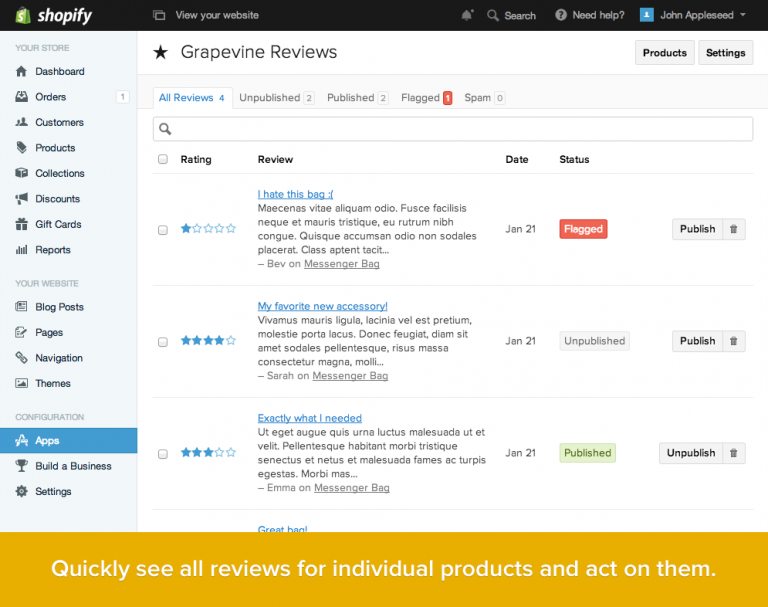
- Placement Matters
Most of the time, a call to action works best when placed at the end of your copy or content. If your particular business makes use of the long-form sales page, putting the call to action higher up is a good idea. You can highlight the benefits of your products and encourage people to buy.
- Make sure you use quality images
Since the technology has evolved so far and one can take a great quality picture, at a high resolution, even with the smartphone there are no more excuses for not using the best pictures possible for your products. You can not only use images to highlight your product’s qualities, but also show it in use to help visitors visualize how the product can be used everyday.

- Great product descriptions
Making it easy for the customers to find the right information and teaching them about the product they are interested in. The writing should be focused on you target and its needs, therefore the tone of voice should be adapted to that. It’s important to focus on the product’s benefits and to keep the language simple, avoiding as much as possible the jargon and write short sentences to help the readability.
- Build Excitement
You need to build up the product or line of products in customers’ minds before asking them to buy. This way, there won’t be any doubt about if they want to take the action you’re calling on them to take. Talk about or show how beneficial what you’re selling can be in the buyer’s life.
- Be Active, Not Passive
“It would be nice if you bought my stuff” is not the same as “Click here to start shopping.” Passive implies that you aren’t sure if you want them to do the thing you’re asking them to do. Active voice removes all doubt about your expectations, shows confidence in your products and brands, which it will bring confidence for the customers as well.
9. Try and have pages as clickable as possible
It helps if you make your call to action an actual clickable link — preferably to your shopping cart (which can say something like “Cart empty! Start shopping here”). This saves the viewer the time of searching for the thing that helps them do what you want them to do. As said earlier, making things easier and comfortable for the shopper only helps your business and your sales.
- Show related products that would look great next to the product they already have in the cart or that would fit perfectly. For example for a photo camera a memory card or different lenses. People tend to buy more this way. It’s an opportunity to increase revenue because it shows items visitors may not have otherwise been looking for and it takes them to pages they may haven’t been interested in entering.
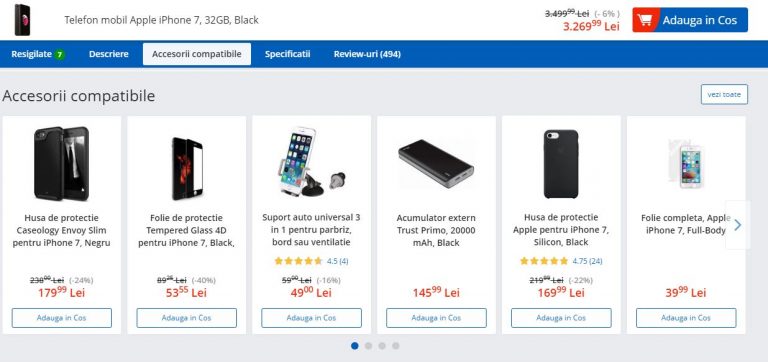
- Easy and safe payment
One of the biggest concerns that people address when it comes to online shopping is the safety of their payment. Make sure you have a trustful provider and that you make the process as easy as possible. Offer them different payment methods, don’t force them to sign up for different offers or newsletters, don’t ask them a bunch of unnecessary information, make sure the checkout page matches the rest of the store. Those would be just some easy, but really important pieces of advice.
- Test, Change, Test Again
Having an online store means constant work of improvement. Even if you have constant growth and awards won, there is always something you can improve. Therefore, test and keep on always testing your website. After all, the final goal is to always keep the costumer happy and wanting to come back and bring more friends along.
